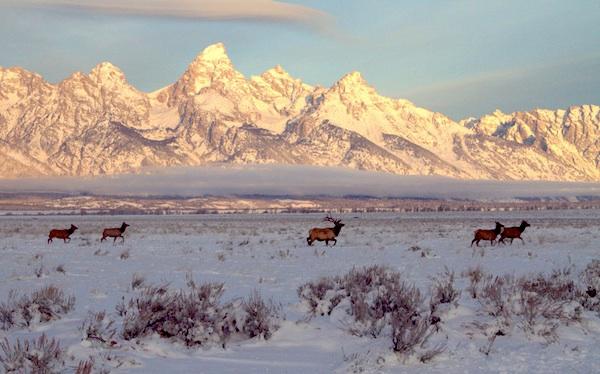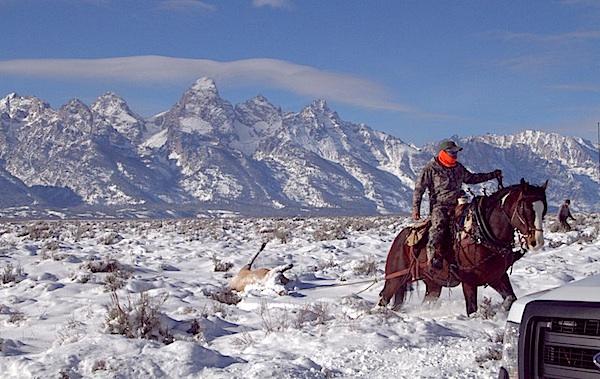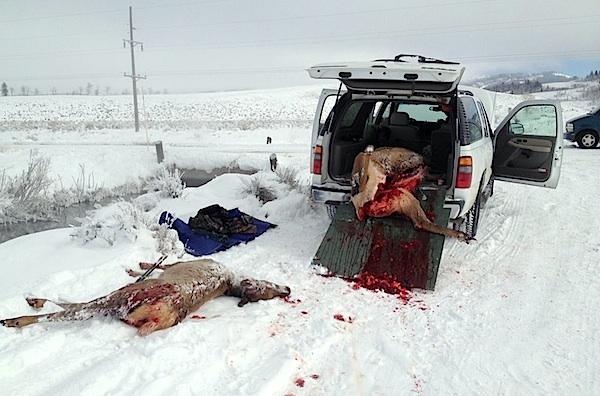
Elk fleeing the hunters/Bernie Scates
In the moments before dawn was to erupt on the landscape, I made out some shapes moving in the sagebrush close to the road. Fearing the possibility of hitting an animal, I slowed down and took a closer look.
Before me were 75 to 100 head of elk with a couple of beautiful bulls in the mix. I pulled over and stopped to watch the animals, mesmerized by their proud beauty and the dawning of a new day in gorgeous Grand Teton National Park. Instead of continuing to my destination at Schwabacher's Landing to photograph the sunrise, I decided to stay and watch the elk, hoping to capture them bathed in the red glow of early morning light.
One thing I will never forget about that November morning in 2013 was the smile on my face and the delight in my heart. That is until I looked into my rearview mirror and terror tore away at my being. I had forgotten about the yearly elk reduction hunt that takes place in Grand Teton every fall.
Hunters were running around their trucks, grabbing orange vests and rifles before tearing off after the elk, all before sunrise. The sun was just about to come up and I had been waiting for about 15 minutes when the hunters arrived. In my mind, I saw myself pointing the camera at the elk, only to have one collapse to the ground in front of me.
I could not bear the thought of watching an animal be killed by a hunter in our national park, and so did not pick up the camera. Panic kicked in. My thoughts were on people driving into the beautiful folds of the Tetons and being greeted by the crack of rifles, blood and corpses, right next to the highway. All of which would have been illegal, but I did not know that then.
And so I did what any indignant, righteous, law ignorant person would do. I started honking my horn. At the time I did not know that it was illegal to interfere with a hunt, which does not make sense to me. What about my rights to not have my photography efforts interfered with? It was clear that elk would be killed, but I was determined that the hunters would have to get off of the road and work for them, and so the honking continued. As it turns out, by law they have to be a quarter-mile off of Highway 89 before shooting an animal, which would have been impossible in that area.
The hunters picked up their pace, gesturing to me as they went. Unable to bear the thought of watching an elk, the beautiful bull in particular, go down, I left. Since then I have learned that only cows and calves can legally be killed in Grand Teton not bulls.
North America's Largest Elk Herd
The Greater Yellowstone Ecosystem, covering about 20 million acres from Grand Teton north through Yellowstone National Park, is home to the largest elk herd in North America, the Jackson elk herd. According to a publication on the park website, "Elk Ecology and Management," there are tens of thousands of elk in this herd and, "Management of the herd is challenging and involves a reduction program in the form of an annual harvest."
Don't you just love that word, "harvest," to describe the killing of wildlife? The use of that word alone tells me that local, state, and federal governments are trying to soften the blows of reality. Not that I am against hunting for food. But hunting in a national park, that does offend me, because I did not spend money for gas, food and a motel room to visit Grand Teton and watch animals be killed by hunters.

Hauling out a kill/Bernie Scates
In 1950, when the boundaries of Grand Teton were expanded, Congress approved a bill that would allow the hunting of elk in the park as a means of population management, "when necessary." From what I can tell, it has been necessary to hunt elk every year for 64 years, despite the wolf and grizzly populations that have supposedly rebounded to numbers large enough to justify the delisting of both species. Wolves prey on elk year-round, while grizzlies kill many newborn elk calves, as well as steal carcasses from wolves.
Despite the large number of elk in the Jackson elk herd that necessitates the annual "elk reduction hunt," elk are fed in winter on the National Elk Refuge that borders the park on the south to ensure their survival.
To further confuse the complex issues that surround the Jackson elk herd and the hunt inside of Grand Teton, in 2012 the herd was said to be about 11,050 animals - just 50 above the target range of 11,000 elk. Begging an answer to the question, if this hunt is about elk management and has nothing to do with man's heritage and a right to hunt elk in a national park, why does the hunt continue when the animal surplus is/was only 50?
I was horrified by the hunt last year, and did my best to avoid the area where the hunters were. Hearing gun fire and watching wildlife fall before my eyes is not why I visit national parks - I, personally visit them because that is where the animals should be safe. And, where wildlife watchers and photographers should be able to enjoy nature while feeling safe ourselves.
Grand Teton's website recommends that hikers in the park wear an orange vest during the hunt, which is something I purchased several years before during my first fall season in the park. But, ultimately it frightened me too much to hike where bullets were flying, and so the vest has never been used.
I believe that the decision to not hike during the hunt was a wise choice, after personal and newspaper reports recounted a elk reduction hunt horror story last week. A well-publicized photograph by Tom Mangelsen showed hunters lined up along the road last Wednesday, rifles ready for an elk massacre. (Click to see Mangelsen's photo and the original story of this event in the Jackson Hole News and Guide.)
Bernie Scates, a Jackson resident and full-time wildlife photographer whose photos are published with this article, stated that a number of hunters were lined up along the road surrounding the area of Kelly, waiting for elk to be herded out of the safe zone, back to the legal hunting area. Scates said that the elk were surrounded by hunters who opened fire and kept shooting until numerous elk were dead, including a couple of spike bulls.
'Hunting in a national park the way it is done in Grand Teton National Park involves herding the elk into the open flats with hunters lining the inner road and firing into the herd hoping to hit them,' Scates said. 'This way there are some elk that are illegally killed, like bulls and spikes, and some that are wounded and never taken care of.'
According to Scates, not only are the laws of the hunt ignored and animals are left to suffer, but he also said visitors are affected. 'Tourists and locals that come into the park hear continuing gun shots and it feels like they could be hit at any moment," he said. "Houses in the Antelope Flats area have many bullet holes in them. Also everywhere people go in the park, that is open in the south area, they witness dead elk being dragged out of the open sage areas onto the road, leaving gut piles and blood everywhere.'
According to Scates and a follow-up article in the Jackson Hole News & Guide, a number of hunters were cited for various offenses.

Elk harvest/Bernie Scates.
Harvesting Vs. Natural Control
Scates is concerned that when the facts are added up, the elk reduction hunt is about money, not wildlife management. 'Why would they continue feeding the elk on the refuge if their numbers are unmanageable?" he asks. "Why not discontinue the feeding program and let nature take its course?"
Another problem that has arisen out of the elk reduction hunt is the possibility that the park's grizzlies are becoming dependent on the hunt.
'The grizzly bears have become dependent on the gut piles for food before going into hibernation,' Scates believes. 'That means that the cubs growing up will not know another way to get their food and could starve - even now in hunting season the bears don't bother to hunt for themselves.'
Scates makes several good points. Why feed the elk if there are so many that a reduction hunt is necessary inside of Grand Teton National Park? It would appear that by feeding the elk, the powers that be are creating the need for the hunt. Also, why doesn't Wyoming create a safe zone for predators around the Greater Yellowstone Ecosystem so that the wolves and grizzlies can manage the elk populations? It would seem like a hunt inside of national park would be a last resort option, not a first line of defense.
Personally, I am offended by the ethics of hunters who would line the road and wait for animals to be herded towards them. Or, who would run out to shoot elk while park visitors are admiring the animals. And, it bothers me that myself or anyone else would pay good money to visit Grand Teton for the magnificent sights that it offers and to see wild animals, only to be confronted by blood, guts, and rifle shots. Will the hunt end when an unsuspecting park visitor is accidentally shot and killed?
The state of Wyoming, members of Congress, Grand Teton National Park officials have a lot of questions that they need to answer, openly and honestly.
Thank you to Bernie Scates for his contribution of photos and an interview for this month's column. Both Bernie and I felt like this is a story that needs to be told time and time again. To see more of Bernie's work, please visit his Facebook page:



Comments
By Mike Koshmrl
Jackson Hole Daily
Witnesses say hunters in Grand Teton National Park drove a herd of elk from a no-hunt zone and toward an awaiting firing line Wednesday.
The scene at the sage flats north of Kelly was a surprise to Michigan resident and Jackson Hole visitor Joanna Childers, who was on a wildlife safari during her first visit to Teton park.
“It looked like a bunch of hunters surrounded a pack of elk,” Childers said. “Hunters were staked out in the road and around the field.
“You see these animals and they’re in a pack and there a bunch of rifles pointed at them from every direction,” she said. “Overall, it was kind of sad and pretty unfair.”
Wildlife photographer Tom Mangelsen — long an opponent of the park hunt — said hunter behavior Wednesday was as egregious as he’s seen.
By Mangelsen’s account, around 11 a.m. a person pushed a herd of about 100 elk out of an area off limits to hunters near Kelly. Once the herd was on the move, chaos ensued, he said.
“All the sudden somebody shot and they just opened fire on them,” Mangelsen said. “It’s really poor sportsmanship — it was illegal and it was just a display of totally barbaric hunting.”
The photographer estimated that 30 people were involved in the drive, that 25 shots were fired and that eight to 10 elk were killed.
Teton park officials did not corroborate many of the details described by Mangelsen and others, but said some hunters were ticketed Wednesday.
“There was quite a bit of action as far as hunters go and the movement of elk near Kelly,” park spokeswoman Jackie Skaggs said. “At least two citations have been issued.”
Two hunters shot and killed bull elk Tuesday in the park, where harvest is restricted to cows and calves. The elk were confiscated by the Wyoming Game and Fish Department, Skaggs said.
One of those hunters was also cited for shooting at a running herd, she said.
Rules unique to the park hunt prohibit firing more than one shot at a group of running animals.
Seven park rangers were still in the field at the time Skaggs spoke with the Jackson Hole Daily, and she said it’s possible there were other violations.
It’s legal for hunters to drive elk out of areas where hunting is prohibited in the park, Skaggs said.
Mangelsen said some people were firing from the road, which is illegal. Photos he provided show hunters with rifles and shooting sticks setting up on the roadside.
Jeff Soulliere, another local photographer, said the display left him speechless.
“It absolutely was a mess,” Soulliere said. “This is a national park, and you’ve got tourists on the road right next to hunters with high-powered rifles.
“It really struck me as, ‘you got to be kidding me,’ ” he said. “No one was taking safety into consideration because they were herding and surrounding them and they could have shot each other.”
A crowd of hunters participating in theTeton park hunt herded elk from a no-hunting area into a barrage of bullets on Wednesday, upsetting nonhunting passersby.
Thomas D. Mangelsen
Kudos to Deby Dixon for writing this article and to NPT for posting it. This hunt is unnecessary and barbaric, and does not fit in any way with the purposes of Grand Teton National Park. I support putting intense pressure on the NPS to end it, once and for all.
Don't quite understand how Scates would deem starving to death a more humane way to die than being shot.
Appalling. And a disgrace.
The refuge was ordered by the court to stop the winter feeding of elk. Unfortunately, the court didn't set a date by which the feeding must stop. Due to the feeding, there is a greater number of elk than the area can support. Also due to the feeding, there is a much greater chance of diseases being tranmitted from elk to elk (chronic wasting has been spreading). The state of Wyoming wants to continue to artificially feed the elk. My guess is so the herd stays unnaturally large, allowing for more hunting.
But, if they stop the artificial feeding, more than half the elk will likely die due to starvation (it is estimated that the herd size is more than double the size that could actually be supported by the land). So, you have a yearly cull to keep the population down to sustainable levels while artificially feeding them or you stop feeding them and let 1/2 of them die slowly.
While I do not agree with the methods the hunters used to 'bag their elk,' I do understand the need for hunting to keep the herd at a healthy size. It seems some hunters were cited, some were ticketed, and one or more lost their hunting priveleges. Maybe the hunt needs to be better managed and those that do not follow the rules or the law have their right to hunt stripped.
In my experience most hunters, like most photographers, are ethical and obey the laws.. In any group of people there will be some who disobey those laws either intentionaly or out of ignorance (road hunting or harrassing hunters with their car horn). Hunters are given a short season to exercise their right to hunt while photographers have no such "season". I understand that many are put off by hunting in general and I certainly don't condone the type of hunt that was described nor would most hunters I know, but then given the authors anti hunting stance suspect the worst example that could be found was used to make a case against hunting. I'm not educated as to Wyoming's fiscal situation but know that in most other states where hunting is popular an enourmous ammount of money is spent by hunters. Money that goes right back into wildlife management and habitat. Photographers are not asked to buy a permit to shoot pictures, or pay a tax on every click of their shutter nor limited to a short season to take their pictures. Something to consider when proposing to take the rights of others away.
My impression of what Scates was saying is that the mission of the national parks is to leave them as natural as possible and not interfere with the life and death of any of the wildlife. I doubt that Scates wants to see anything starve to death but the government has created an artificial situation and eventually it needs to be dealt with in some manner, whether that is reducing the amount of food that is given to the elk, a little at a time, giving them a chance to acclimate to living wild, or what, I do not know.
Deby--thank you for expressing what many of us have felt for a long time.
Rick